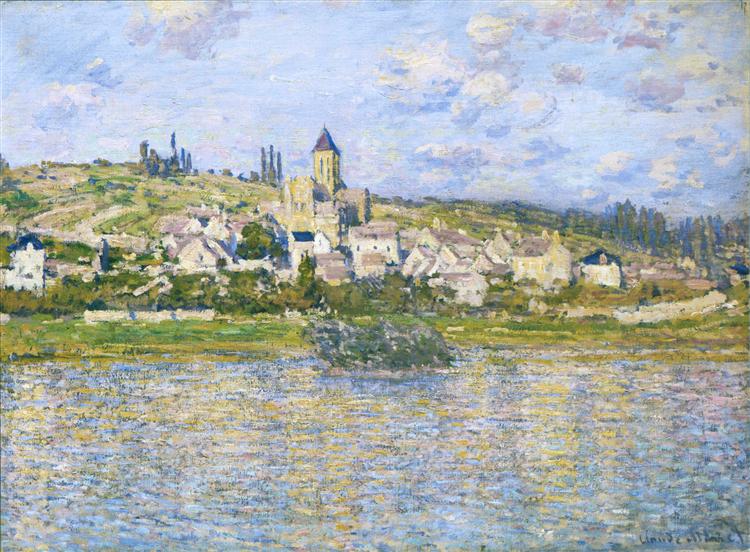Description
L'œuvre "Vétheuil" de Claude Monet, réalisée en 1879, est un exemple magistral de l'attention de l'artiste à la lumière et à l'atmosphère du paysage. Dans cette peinture, le peintre capture un moment idiosyncratique de la ville de Vétheuil, un endroit très aimé de lui, situé sur les rives de la rivière Seine. Monet, l'un des fondateurs de l'impressionnisme, cherche dans ce travail pour transmettre non seulement l'apparence du paysage, mais aussi l'émotion qui le cause.
La composition de "Vétheuil" est magistralement structurée, où le ciel et l'eau jouent un rôle crucial dans le récit visuel. La scène est dominée par un large ciel bleu qui est parsemé de nuages blancs, qui génère un jeu de lumières et d'ombres qui se reflète dynamiquement dans l'eau de la Seine. Cette réflexion n'est pas simplement un miroir de la réalité, mais une interprétation de l'état émotionnel de l'artiste et sa perception de l'environnement. La surface de la rivière, avec son traitement fluide, suggère à la fois le calme et le mouvement, révélant l'intérêt de Monet pour les propriétés éphémères de la lumière.
Au premier plan se trouve un ensemble de maisons et d'arbres qui encadrent la vue. Monet utilise des coups de pinceau lâches et rapides, une technique caractéristique de l'impressionnisme, qui vous permet de capturer l'essence du lieu plus que son détail exact. La richesse du vert et du brun dans la végétation contraste avec les tons bleus et gris de l'eau et du ciel, créant un équilibre harmonieux dans la palette chromatique. Cette palette, qui comprend également des tons chauds et doux dans les espaces de lumière, offre un sentiment de chaleur à la composition et évoque l'atmosphère d'un après-midi calme.
Alors que dans "Vétheuil", il n'y a pas de figures humaines exceptionnelles, les empreintes de la vie quotidienne sont subtilement insinuées. Les constructions sur le rivage de la rivière suggèrent la présence d'habitants qui jouissent du paysage, ce qui fait que la peinture se sent animée bien qu'elle soit dépourvue de personnages directs. Cette approche est également typique dans le travail de Monet, qui a souvent choisi de souligner le paysage au-dessus de l'intervention humaine, permettant à la nature de parler d'elle-même.
Les travaux font partie d'une série de paysages peints dans cette région et reflètent l'attachement profond de Monet pour les variations de la lumière tout au long de la journée et des stations. Il a monumentalisé non seulement son environnement, mais aussi une période de sa vie où il a trouvé la paix et le refuge dans la nature.
Grâce à sa technique innovante et à son accent sur la lumière et l'atmosphère, Monet capture non seulement un endroit spécifique, mais offre également une méditation sur l'impermanence, un thème récurrent dans son travail et en général dans l'impressionnisme. Dans ces moments éphémères, le spectateur est invité à contempler et à se connecter émotionnellement à la sérénité et à la beauté du paysage naturel, encapsulant l'essence du mouvement que Monet lui-même a aidé à fonder. "Vétheuil" est, en bref, une œuvre qui non seulement dépeint un endroit, mais offre également une réflexion sur le temps, la mémoire et l'expérience d'être en harmonie avec la nature.
KUADROS ©, une peinture célèbre sur votre mur.
Peintures à l'huile fabriquées à la main, avec la qualité des artistes professionnels et le sceau distinctif de KUADROS ©.
Service de reproduction des images avec garantie de satisfaction. Si vous n'êtes pas complètement satisfait de la réplique de votre peinture, nous remboursons votre argent à 100%.

